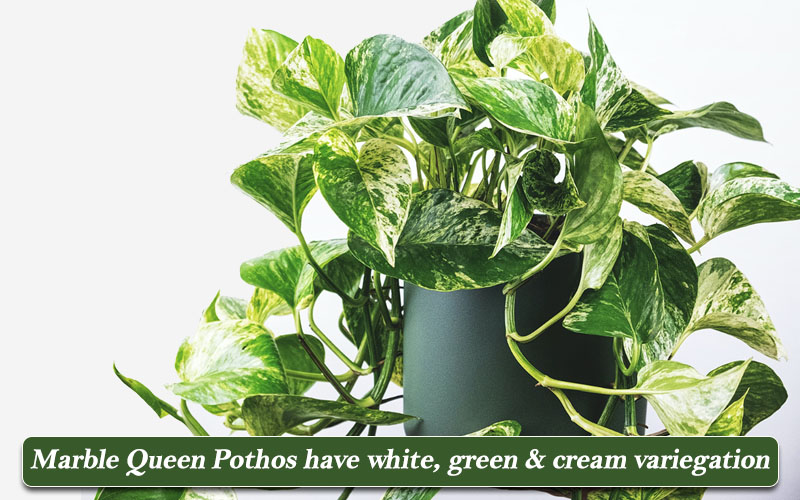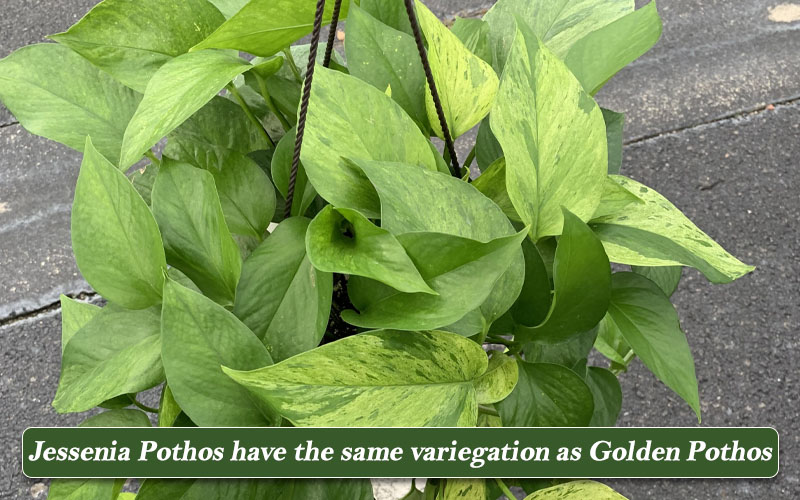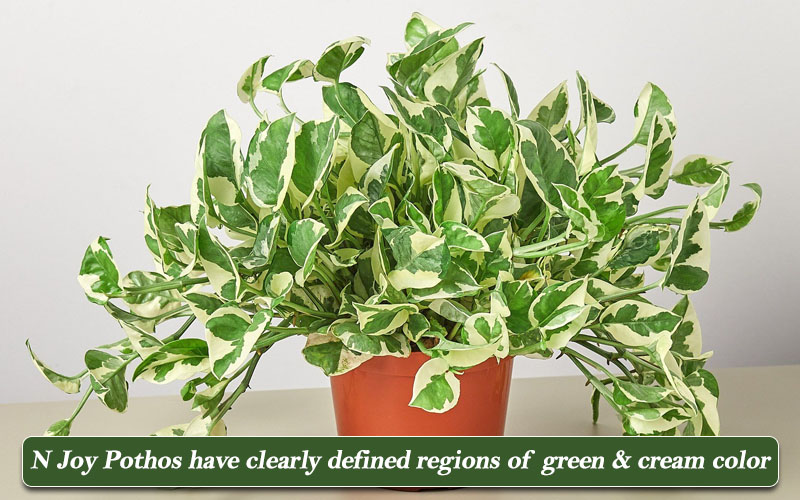There are so many easy plant options to grow indoors.
Low light succulents like Echeverias and Jade plant.
Or plants like Dumb Cane and Peace Lily.
But it wouldn’t hurt a bit if there were more of such plants, right?
Pothos is one such genus. It is arguably the easiest houseplant that even a novice gardener could grow.
And much to your excitement, there are several types of Pothos you can choose from.
Below are 11 of them.
Table of Contents
Variegated Pothos types
The reason for discussing these Pothos varieties first is because it’s the most abundant subtype.
1. Manjula Pothos

This patented variety is produced by the University of Florida.
Leaves: It has got heart-shaped leaves with wavy edges that never stay flat. Marked by golden and cream patches, each leaf will be different from the other, extremely pleasing to the eye if we become fully honest with you.
Some leaves will be green with white marks on the edges, while some will be creamy-white with green spots; each new leaf is a mystery in itself (Enjoy every new growth 😊).
Size: Manjula Pothos is not a fast grower. It grows 1-2 feet tall at most and spread about the same length as well.
Sunlight: Bright, indirect light is the best. If you keep it in direct sunlight, the variegation will reduce and you will get greener leaves.
Also, there is a great chance that the white and cream marks will be scorched by the sunlight.
Water requirement: It likes moist soil but not soggy. Water it, once the soil’s top layer is completely dry. Reduce the frequency of watering in winters.
Soil: We researched a lot and found an extremely appropriate soil mix for you: It’s 50% potting mix, 25% perlite, and 25% cactus mix.
The composition can vary in results depending on the weather conditions of the State you live in. Prepare the mix on a gardening mat.
Growth rate: It grows slowly because of the variegation. The white and cream variegation means it lacks chlorophyll, which ultimately means less food for growth.
2. Marble Queen Pothos

Very identical to the Manjula Pothos, this green-white beauty lightens up the corners of your room or office artistically.
Leaves: The leaves are heart-shaped and have a dark green color, speckled by white or silver patches. The edges can be wavy or flat.
People are usually confused by this and the Manjula Pothos plant but there are marked differences.
Manjula Pothos have leaves that have golden, cream, and green variegation while Marble Queen Pothos have green, cream, and white variegation.
Also, the patches are quite distributed in Manjula but there is more of speckling in the case of Marble Queen.
Size: Marble Queen Pothos can be expected to grow to 3 feet, although slowly. It loves to spread or trail downwards and can spread a lot if not pruned.
Sunlight: It can tolerate shade but prefers medium to bright indirect sunlight. Like the Manjula Pothos, the leaves will turn green if not given proper light.
If kept in direct sunlight, the leaves will burn so avoid doing that.
Water requirement: Water it once the top layer of the soil is dry in Summers and Spring. In Winters, however, wait till the whole of the soil has dried first.
For that, wait till you notice the leaves drooping slightly and then water it.
Soil: Add a well-drained and aerated soil mix for healthy growth. If you notice a problem in the drainage of the soil, add some sand mix.
A great composition is an equal mix of peat moss, perlite, and soil mix.
Growth rate: It grows faster than the Manjula Pothos. This is also a trailing plant and you can grow them in pots or hanging baskets.
Be sure to prune the long vines every few months so that the plant remains bushy.
3. Golden Pothos

It is the most common type of Pothos and is probably the easiest in terms of care. You can find this trailing variety abundantly in nurseries or online platforms.
Leaves: Golden Pothos is characterized by heart-shaped green leaves that are blotted with golden marks all over irregularly. The degree of variegation depends on the sunlight.
The greater the light intensity, the more pronounced the variegation will be.
Size: Young plants grow to 6 inches in height but it is a fast-growing variety and can grow to 10 feet if not pruned.
You can start from a small pot and repot it after the pot seems overcrowded.
Sunlight: It prefers bright, indirect light.
Water requirement: Water when the top 2 inches of the soil is dry. Generally, water it after every 1-2 weeks.
Growth rate: How quickly do Golden Pothos plants grow? Well, it depends on the weather and the light intensity.
If kept in the shade indoors, it grows very slowly. The pace enhances if kept in bright, indirect light indoors or grown outdoors in a shady spot.
It grows even faster when attached to a pole or any support.
4. Jessenia Pothos

This trailing vine is hardy enough to grow in varying conditions. It resembles closely to the Golden Pothos. We prefer pairing it with the white-green Pothos for a vibrant effect.
Jessenia Pothos can be regarded as the rarest Pothos. You cannot find it as easily as the Golden Pothos.
Leaves: The leaves are green in color with hues of golden and yellow in them. Sometimes, it is in the form of thin, river-like lines and sometimes, in the form of spots or large dots.
Size: According to plantcaretoday, it can trail to 10 feet tall indoors.
Sunlight: Like other Pothos, it grows best in bright, indirect light. That being said, it won’t stop growing in the shady or dark corners of your house so you are in luck with this plant if you have a dark room.
Water requirement: Water it after 8-14 days. The good thing is that it won’t be sad if you forget to follow this water cycle.
Soil: Nothing special. Normal well-drained soil will do just fine.
Growth rate: It grows slower than the Golden Pothos but faster than the Marble Queen and Manjula Pothos. You can play with the humidity and light intensity levels to enhance the growth rate.
5. Pearls and Jade Pothos

This is a sport variety of Marble Queen and is often confused with NJoy Pothos. We will discuss the difference below.
Leaves: It features grey-green leaves streaked with cream or silver-grey variegation that is concentrated at the edges.
They are small in size than general Pothos leaves and are speckled with green dots in the cream-white region.
Size: It grows to 2-5 feet in spread and 6-8 inches in height. As it is a trailing variety as well, so if you consider growing it in hanging baskets, it would grow till 6-10 feet.
Another great trailing houseplant is the Peperomia Prostrata.
Sunlight: Bright indirect sunlight.
Water requirement: They need water after 1-2 weeks. Don’t overwater it as it will cause root rot. It would also help if you occasionally mist it with a water gun as it belongs to a tropical heritage.
Soil: Well-drained and well-aerated soil having a pH of 6-7.
Growth rate: It grows at a slower rate than the other Pothos. You would only get a few inches in months.
6. N Joy Pothos

N Joy Pothos is a close relative of the Pearls and Jade Pothos.
Leaves: It has heart-shaped leaves that are cream and green in color.
N Joy leaves are clear with no dots on them. The cream and green regions are defined by clear edges, whereas the leaves of Pearls and Jade Pothos are speckled with green dots.
Size: It can trail up to 10 feet in size. If we talk about the height, it will be about 9 inches max.
Sunlight: Same as Pearls and Jade Pothos.
Water requirement: Water it when the top 1-2 inches of the soil is dry.
Soil: Equal parts of peat and perlite.
Growth rate: It is a fast grower and can become leggy if not pruned on time. Also, if your plant is leggy, put it at a spot that receives a good amount of indirect light.
7. Glacier Pothos

The Glacier Pothos is another trailing variety that is confused with N Joy and Pearls and Jade Pothos. The major difference is that the Glacier Pothos have more blotching than the other two.
Leaves: The small leaves are dark or green in color with cream-colored patches.
Size: It grows to a size of 20 inches.
Sunlight: Bright and indirect light is the best.
Water requirement: Its water needs are not different from other Pothos. Water them once a week in Summers and once every 2 weeks in Winters.
If the leaves are curving, water them instantly. It is an indication that the plant requires water.
Soil: Good quality organic potting soil that is peat-based.
Growth rate: Not defined.
8. Satin Pothos

Satin Pothos or Scindapsus Pictus is a vining plant with miraculous green and silver leaves.
Leaves: It has large arrow-shaped leaves that have dark green and silver marks. Sometimes, the silver marks overpower the green colors and at other times, green does.
Size: Around 3 feet.
Sunlight: Place it close to a sun-facing window because otherwise, it would start growing small leaves.
Water requirement: Once a week is enough. If the leaves are curling, it means it needs water.
Soil: Equal amount of soil mix and perlite mixture. If you water less, then make the composition 60% soil and 40% perlite.
Growth rate: It grows slowly and moderately, although bright indirect light can speed up the growth process. Adding a 20-10-10 fertilizer is another catalyst for growth.
Non-variegated Pothos varieties
Variegation is extremely common in Pothos, but there are still some non-variegated varieties.
Let’s diversify your vision with them.
9. Neon Pothos

Known for its bright, neon-colored leaves, Neon Pothos is also very easy to take care of.
Leaves: They are heart-shaped and have bright neon color. People are instantly drawn to this luster on the leaves but be wary, if it is not kept in bright light, the color may become dark and dull.
Size: Grows to about 2-3 feet but if you allow it to hang from pots, it can reach 6-7 feet as well. They are ideal for sprucing up the office and room corners.
Sunlight: While low light will make the leaves dull, long exposure to sunlight will make the leaves pale. The balance is very important here.
They can grow in a bathroom as well but the color and presentation people long for in this plant can only be achieved if it is placed near a window receiving 4-5 hours of light daily.
Water requirement: Water once a week. Don’t over-fertilize Neon Pothos as it will kill it.
Soil: Organic potting soil with peat moss or coco peat.
Growth rate: They are normal to fast growers if provided with optimum conditions. High humidity or low light will reduce the rate of plant growth.
10. Jade Pothos

Although it might show slight variegation, we have included Jade Pothos in this category because the degree of variegation is very low. It is a new variety and rare to find.
Leaves: They have waxy green leaves that become darker in color as they mature. The veins of the leaves can be clearly seen with the naked eye.
Size: Generally not more than 1 foot.
Sunlight: Requires medium to low, indirect light.
Water requirement: Once a week in Summers and Spring. Once every two weeks in Fall and Winters.
Soil: Well-drained potting mix with a handful of perlite to increase the soil drainage.
11. Cebu Blue Pothos

Cebu Blue is not exactly blue but silverish shiny green.
Leaves: The arrow-shaped or oval leaves have a silver-blue hue in them at their young age. As they mature, the silver tint disappears.
Size: Anywhere between 1-4 feet. If you allow them to trail down a basket, they can grow to a more considerable height.
Sunlight: They grow the best in bright, indirect light. They shouldn’t be kept in bright direct light because that will scorch the foliage.
Water requirement: Water them a bit more frequently than you do with other types of Pothos. They like a humid environment so consider placing them in a tray of water filled with gravel.
Soil: Normal potting mix with a touch of orchid bark is fine for this plant.
Growth rate: They are not fast growers like the Golden Pothos.
Bottom line
That’s it for the Pothos varieties. Keep visiting our Gardening articles at Inspire Uplift Blog for more helpful info.

